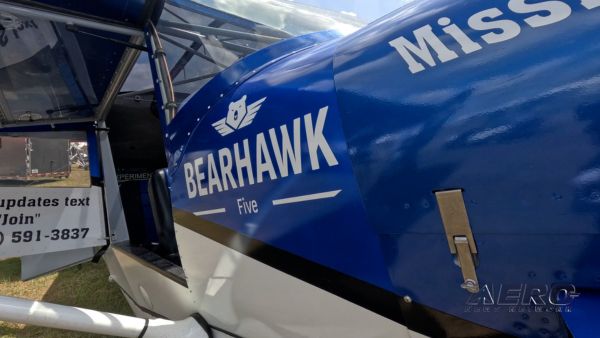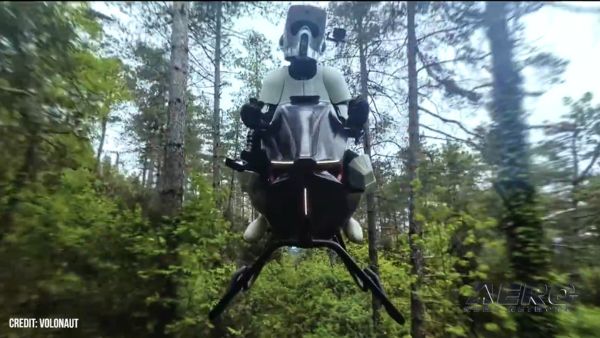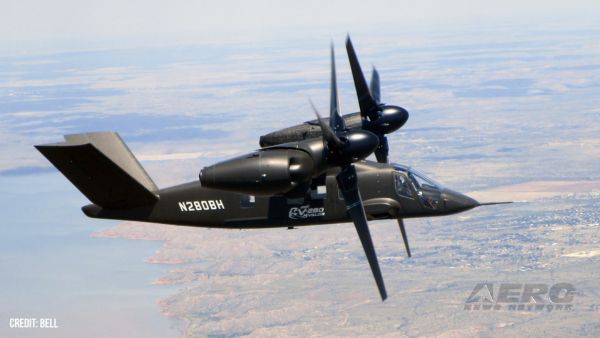"Latest, Greatest Thing"
By ANN Reporter Kevin O'Brien
For the first several days of the show, a blue and white tent
covered…something.
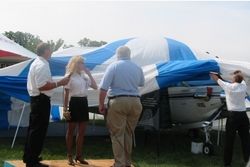 The
Aero-News.net crew knew what was in the tent, but we were sworn to
secrecy. [Note to manufacturers, airlines, airport operators, and
bureaucrats: we will get our mitts on your deepest,
darkest secrets, so you might want to think about just giving 'em
up while you can still set some conditions. -KO] So when the thing
was finally set to be unveiled, we made sure to be there.
The
Aero-News.net crew knew what was in the tent, but we were sworn to
secrecy. [Note to manufacturers, airlines, airport operators, and
bureaucrats: we will get our mitts on your deepest,
darkest secrets, so you might want to think about just giving 'em
up while you can still set some conditions. -KO] So when the thing
was finally set to be unveiled, we made sure to be there.
Uncharacteristically, I was early. The entire staff of Rocket
Engineering was there… and as nervous as a herd of house
cats on bath day. This was clearly a really big announcement for
them. I found myself wanting the launch to be flawless. Of course,
the sound system wheeled in for the occasion by EAA volunteers
immediately glitched. That was the only thing that wasn't perfect,
in the entire event.
Darwin Conrad and Jeanie Sadler, the founders of Rocket
Engineering (and before that, of JetProp LLC, which continues to
operate), took the stage with Dave Keim of the EAA Interview
Circle. The introduction was scripted as an interview by Dave, a
hearty guy with an easy manner, and Darwin and Jeanie are friendly,
open people, so any nervousness dissipated instantly as Dave asked
questions about the history that led to this plane.
"This is the latest, greatest thing," Darwin said. After
describing his history of hot-rodding airplanes, he launched into a
description of the design and specs of the new machine: the specs
were pretty impressive, including a 260-kt cruise.
Then he told us the name. Finally, it was time to unveil
the plane called TurbineAir.
Up Goes the Veil
Staffers in Rocket Engineering shirts smoothly lifted the blue
and white Big Top. As it started to go up, curious passersby
augmented the crowd of reporters. Some of them had been lurking in
the shade of the Cessna Pilots Association nearby, watching and
waiting for the unveiling.
"What is it?"
"I think it -"
"Wait -"
"A Bonanza! It's a Bonanza!" shouted someone with an Italian
accent.
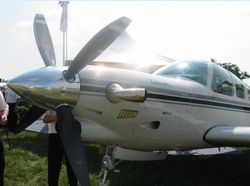 Sure
enough, it was a Bonanza. Rocket Engineering's new TurbineAir (a
name chosen to have a vague feel of Beech history, reminiscent of
TravelAir) is a flawless PT-6 conversion of a Beechcraft Bonanza
B35TC.
Sure
enough, it was a Bonanza. Rocket Engineering's new TurbineAir (a
name chosen to have a vague feel of Beech history, reminiscent of
TravelAir) is a flawless PT-6 conversion of a Beechcraft Bonanza
B35TC.
And what a Bonanza it is: the elegantly-cowled nose looks like a
factory installation. The timeless lines of the Bonanza are, if
anything, enhanced by the new proboscis. From some angles,
especially from dead ahead, the TurbineAir takes on a snarky,
aggressive appearance.
With the cowl off, it still looks like a factory installation.
The ductwork and finish of the installation are
first-rate.
Along with the powerplant and associated changes, the TurbineAir
gets some subtle aerodynamic mods: a couple of stall strips on the
wing leading edge, and a stall fence near the tip. Two large
angular structures on the leading edge that I thought might have
been some bizarre part of the aero mods were patiently explained to
me, in simple words, as antennae for the radar.
Inside, the Bonanza has a jet-worthy panel with state-of-the-art
Garmin GNS 530 and GNS 430 GPS/Nav/Comm boxes, plus radar.
What About the STC?
If we were a print publication, they would probably have the STC
by the time you had read this. But we ain't, and they won't. I
love hearing FAA horror stories, and asked Darwin for his. Maybe it
was that the STC is still dangling in the balance, but he
didn't have any… it's just been a long drawn-out process,
and just when he thought it was over, it was drawn further out by a
letter asking for documentation of two more items. They sent the
documentation, but are still waiting for the FAA to review and
accept it (which all parties seem to think is most likely). So the
best guess is that the STC is about three or four weeks out.
The plane is pretty well proven. It has been flying on the PT-6
for two years, while the STC process has inched along at the speed
of Fed.
Just one Bonanza model, so far...
The STC only applies to the B35TC… if you have another
model of Bonanza, you're out of luck (well, anyone who owns a
Bonanza is in luck… you are just not as in-luck as
you might be).
They Had a Little Help…
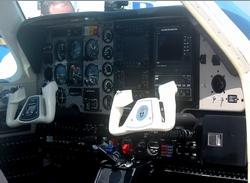 Certainly Rocket Engineering can be proud of the job they have
done here. The lion's share of the credit must go to those that
actually did the work, and to the experience they have gained in
turbinizing (is that a word? It is now…) 100 Malibus. But
they had help from a variety of partners, many of whom attended the
unveiling and helped explain their share of the plane's features.
Rocket couldn't have done it without help from Pratt & Whitney
and Hartzell, and some of the smaller vendors like Garmin that
provided the GNS 530/430 GPS/Nav/Comm stack and Shadin that
provided the Shadin Engine Trend Monitor.
Certainly Rocket Engineering can be proud of the job they have
done here. The lion's share of the credit must go to those that
actually did the work, and to the experience they have gained in
turbinizing (is that a word? It is now…) 100 Malibus. But
they had help from a variety of partners, many of whom attended the
unveiling and helped explain their share of the plane's features.
Rocket couldn't have done it without help from Pratt & Whitney
and Hartzell, and some of the smaller vendors like Garmin that
provided the GNS 530/430 GPS/Nav/Comm stack and Shadin that
provided the Shadin Engine Trend Monitor.
What About Those Specs?
In order to get to the unveiling more quickly, I didn't give you
a lot of the specs that Darwin gave us. The TurbineAir can:
- Cruise at 260 kt
- Climb 3,000 ft/min
- Travel 900 nm on 120 gallons of Jet A
- Lift a 500 lb. Payload with full fuel.
- Go 4,000 hours before an engine overhaul (no hot section
inspection in that time either)
The TurbineAir is a cousin of the JetProp DLX, and the
powerplant is about the same, although there are naturally
differences in mounts and cowling dictated by the different
airframes.
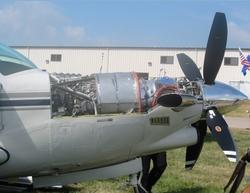 The
TurbineAir uses the Pratt and Whitney Canada PT-6-35 engine.
The -35 is being installed in current production JetPropDLX
conversions, although until recently the -34 was in use.
JetProp/Rocket has worked closely with Pratt in the development of
this engine, which is the -135 with the gearbox from the -34. It
has given the JetPropDLX an edge, upping that machine's cruise from
a respectable 260 to a more respectable 275 kt. (So the JetProp DLX
has a slight speed edge over the TurbineAir -- plus, of course,
pressurization…and it's a heck of a lot more
money).
The
TurbineAir uses the Pratt and Whitney Canada PT-6-35 engine.
The -35 is being installed in current production JetPropDLX
conversions, although until recently the -34 was in use.
JetProp/Rocket has worked closely with Pratt in the development of
this engine, which is the -135 with the gearbox from the -34. It
has given the JetPropDLX an edge, upping that machine's cruise from
a respectable 260 to a more respectable 275 kt. (So the JetProp DLX
has a slight speed edge over the TurbineAir -- plus, of course,
pressurization…and it's a heck of a lot more
money).
The PT-6 drives one of two Hartzell four-bladed propellers,
depending on the owner's preferences. One of them is a custom-made
composite propeller and the other a more traditional aluminum. The
composite prop is also used on the JetProp, and the alloy one is
also used on the Malibu Meridian. The composite prop is made of
Kevlar; it's a little lighter than the metal one... and a lot more
money.
History of the Firm
While Rocket Engineering is a new firm, its principals and its
staff are largely shared with JetProp, LLC. The history of these
principals as performance tuners is long indeed. It begins with
big-block conversions for Mooneys. Quite a few of those were sold
(around 250).
After that came the groundbreaking conversion for the Malibu.
100 JetProp conversions are flying and they are continuing at the
rate of three a month, despite Piper having made a dent in this
market by releasing their own PT-6 version.
What Does It All Cost?
You can fly away in a TurbineAir for about $700,000 to $750,000
complete. Maybe even under $700,000. That's including the B35TC (as
noted above, this is the only model of the prolific Bonanza family
to which the STC applies). Of this cost, the conversion is $400,000
to $450,000, and at present a really clean B35TC (I can't imagine
doing this conversion on a beater) is $200,000 to
$250,000.
The 4,000-hour TBO reduces maintenance costs -- to a point. When
that overhaul comes, it's going to be expensive by piston
standards. It's the price you pay for turbine power and
reliability.
Insurance is a big factor in plane ownership. JetProp has been
paying $25,000 a year but they have two customers in the JetProp
that pay $6,000 a year for insurance.
Wrap-up:
The TurbineAir is an attractive choice for the business
traveler who values time. The simple, reliable PT-6 should
simplify the complicated process of flying the Bonanza a little.
The need to fly on O2 to get the best out of the plane will not
please some flyers, who would rather spend similar money to go
slower in a pressurized piston machine. For many others, 'masking
up' is a small price to pay for 260 knots.
The safety benefits of the PT-6 conversion can't be overstated.
While the certain-as-sunrise reliability of the PT-6 is one safety
feature that should be clear to everyone, take a moment to think
about the 3,000-ft/min rate of climb. That makes mountains
seem smaller all of a sudden. The ability to make equally abrupt
descents without risking damage to the engine may not be as great a
safety benefit, but it takes one bit of grief out of dealing with
ATC.
There are compromises, sure. One of them is the low useful
load with full fuel versus the low range with full seats. On the
other hand, you're going so fast, and it's so much fun, you might
want to stop on the way every three hours or so, just to
brag...
 ANN's Daily Aero-Term (05.19.25): Fuel Remaining
ANN's Daily Aero-Term (05.19.25): Fuel Remaining ANN's Daily Aero-Linx (05.19.25)
ANN's Daily Aero-Linx (05.19.25) Klyde Morris (05.16.25)
Klyde Morris (05.16.25) Airborne 05.19.25: Kolb v Tornados, Philippine Mars, Blackhawk Antler Theft
Airborne 05.19.25: Kolb v Tornados, Philippine Mars, Blackhawk Antler Theft Airborne-Flight Training 05.15.25: Ray Scholarship, Alto NG, Fighter Training
Airborne-Flight Training 05.15.25: Ray Scholarship, Alto NG, Fighter Training




